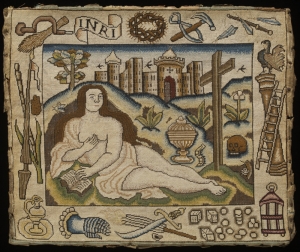By the sixteenth century the term (originally French) term of ‘embroidery’ started to refer to rich materials that were either embellished with stitching or with applied cloth decoration. This form of work was generally free style in appearance. The person (male or female) who carried out this type of work was generally called an embroiderer. The same division between needlework and embroidery still exists in the twenty-first century, although the two terms are often used synonymously.
See also the TRC Needles entry on needle.
Sources:
- LEVEY, Santina M. (1998). An Elizabethan Inheritance: The Hardwick Hall Textiles, London: The National Trust, pp. 48.
- Shorter Oxford English Dictionary: 'Embroidery', 'Needlework'.
V&A online catalogue (retrieved 9th July 2016).
GVE

